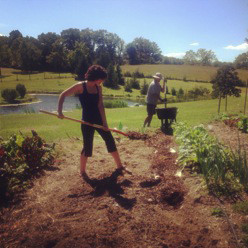As changemakers and service providers, we come from a culture that trains us to identify problems: obesity rates, percentages of impoverishment, degrees of blight. This lens of scarcity exposes harsh and important realities, but it is also a distancing lens. When we see only problems, too often our response is to marshal non-local resources and top-down interventions. Worse, our own history and experience frames our understanding of these problems. We may assume, for example, that vacant storefronts are merely indicators of economic failing, rather than seeking the views of people who sleep in them or the members of youth bands that practice in them.
To create systems of change that act with communities rather than to them, we must see the potential solutions that are already embedded in communities—solutions often hidden in the most obvious places, masquerading as problems.

In fact, some imposed solutions can be harmful, and what we consider harmful can be transformative. Permaculture, a design system focused on building interconnected and sustainable systems, holds that any resource in excess becomes a pollutant. In an agricultural context, excess animal waste destroys streams in runoff proportions, but in proper and integrated doses, it is vital to maintaining soil fertility and a regenerative ecosystem. In a social setting, “pollutants” such as unemployment or vacant buildings can indeed cause harm, but they may also hold hidden potential and assets for local communities.
My own community, Staunton, Virginia, had a familiar problem. After several decades of focused downtown revitalization efforts, this small southern city with a rural heritage began seeing a proliferation of entrepreneurial small businesses that had incredible talent—web-designers, accountants, massage therapists, nutritionists, and bike mechanics—but lacked the cash necessary to procure each other’s services. The potential seemed great, and the problem seemed obvious: While time and talent were plentiful, the businesses needed more money.
In response, the local government—in partnership with a new nonprofit community development agency, the Staunton Creative Community Fund—launched micro-lending programs funded with public and non-local dollars; the programs provided loans to support start-up and working capital for the local businesses. For several years, I served as the executive director of the agency, and to a degree it worked. Today, data shows that the initiative supported hundreds of thousands of dollars in microloans, and that there were strong rates of repayment over the lifetime of the portfolios.
Yet while these measures capture the outputs of a microloan program, they don’t necessarily capture the true extent of local exchange or business health. Are businesses better off after loan repayment? Did the microloans actually help local entrepreneurs and their businesses become happier, healthier, and more vibrant? Perhaps most to the point of this article, how could we achieve the original goals using local resources and talent, rather than relying on outside funding?
The microloan program continues to provide a valuable tool to the local entrepreneurial community, but several years ago a coalition of local residents, businesses, and the community development organization that originally launched the microloan program decided to begin a complementary initiative—this time less reliant on outside financing, and more accessible to residents and entrepreneurs who aren’t necessarily good candidates for loans. Focusing on local solutions, the new initiative began with what was abundant (time and talent) rather than focusing on what was scarce (money). These local businesses had the services to meet each other needs, but they didn’t always have the means to unlock those services. Our preconceived notion said that money was the only way to catalyze this exchange—but was it?
Rather than trading dollars, member residents and businesses can now pay each other in hours. We call this hOUR Economy, and it operates as a local time bank. The hours circulate throughout the community, allowing a nutritionist to access videography, a videographer to get gardening help, a gardener to earn a much-needed massage, and so on. The resource these businesses had in greatest excess—time and talent—became their currency of exchange. In the time bank, everyone’s hour is equal, and services that are often undervalued in the traditional monetary economy (childcare, elder care, and cooking, for example) are more formally recognized and rewarded.
 A local nutritionist, Anne Buzzelli, works for hOURs in a market garden. (Photo by Meghan Williamson)
A local nutritionist, Anne Buzzelli, works for hOURs in a market garden. (Photo by Meghan Williamson)
Elsewhere, access to health care has become a cornerstone of a more-developed time bank, Hour Exchange Portland, located in Portland, Maine. Working with both traditional and non-traditional health and wellness providers, time bank members can access healthcare using hours rather than dollars. Rather than seeing recipients of this care simply as “uninsured” or “poor,” the program recognizes them for their other contributions—again, measured in hours rather than dollars.
What other overlooked resources could we incorporate into community renewal and health? Abandoned lots can transform into urban gardens. Vacant buildings can become experimental spaces for pop-up stores and entrepreneurs. Artists can spark much-needed community conversations and collective visioning. What knowledge, compassion, and resources do those who most need services already have, and how can we collaborate to build more-vibrant communities?
Good program design begins with understanding the problems—as the community itself experiences them—and then identifies local assets that the community can deploy as solutions. Good program evaluations embody these insights, step by step.
Inverting our “solution” paradigm should not become an excuse to remain blind to external harms that programs can inflict on communities. But as we work to remove these external causes of harm, we must also work with communities; we must listen to and recognize communities as whole, complex system capable of great self-agency and even greater self-healing.
Support SSIR’s coverage of cross-sector solutions to global challenges.
Help us further the reach of innovative ideas. Donate today.
Read more stories by Meghan Williamson.

